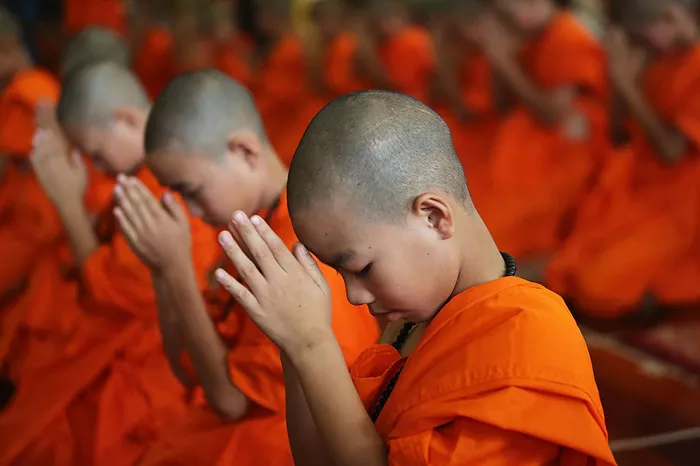Buddhism, with its rich tapestry of traditions and cultures, offers profound insights into the nature of existence. A notable aspect of this spiritual path is the practice of monks adopting new names upon their ordination. This tradition, deeply rooted in symbolism and purpose, serves as a significant milestone in a monk’s spiritual journey. In this article, we will explore the reasons behind this practice, its historical context, and its variations across different Buddhist traditions.
The Essence of a Name in Buddhism
In many cultures, a name is more than just a label; it carries deep significance, reflecting one’s identity, heritage, and aspirations. In Buddhism, names are not merely identifiers but are imbued with spiritual meaning, guiding the individual’s path toward enlightenment.
Dharma Names: A Symbol of Transformation
Upon entering monastic life, individuals often receive a new name, commonly known as a Dharma name. This name signifies a transformation—a shedding of one’s former identity to embrace a life dedicated to the Dharma (the teachings of the Buddha). The act of renaming is symbolic of leaving behind worldly attachments and embarking on a path of spiritual awakening.
The practice of assigning Dharma names varies among different Buddhist traditions:
Mahayana Buddhism: In Mahayana traditions, both lay practitioners and monastics receive Dharma names during initiation rituals. These names are considered aspirational, reflecting the individual’s spiritual goals and the qualities they wish to cultivate. For example, the Vietnamese Zen master Thích Nhất Hạnh was given the Dharma name Nhất Hạnh, meaning “One Action,” symbolizing his commitment to mindful living.
Theravada Buddhism: In Theravada traditions, the naming convention is slightly different. Monastics receive a Pali name upon ordination, often consisting of a title and a personal name. This name is used within the monastic community and signifies the individual’s commitment to the monastic life.
Historical Context: The Evolution of Name Changes
The practice of changing one’s name upon entering monastic life has evolved over time:
Early Buddhism: During the time of the Buddha, it was not common for monks and nuns to change their names. Notable exceptions include Sariputta and Moggallana, who were known as Upatissa and Kolita, respectively, before their ordination.
Development of Traditions: As Buddhism spread across Asia, different cultures and traditions developed their own customs regarding monastic names. For instance, in Chinese Buddhism, monastics often adopt a Dharma name that reflects their lineage or the qualities they aspire to embody.
The Significance of Monastic Names
Monastic names hold profound significance in a practitioner’s life:
Spiritual Identity: The new name represents a fresh identity, free from past attachments and ego. It serves as a constant reminder of one’s commitment to the Buddhist path.
Connection to Lineage: The name often connects the individual to a particular lineage or tradition, linking them to a lineage of teachers and teachings that have been passed down through generations.
Expression of Aspirations: Many monastic names are chosen to reflect the qualities or virtues the individual wishes to cultivate, such as wisdom, compassion, or mindfulness.
Legal Names vs. Monastic Names
It’s important to distinguish between legal names and monastic names:
Legal Names: These are the names given at birth and are used in secular matters, such as legal documents and identification. Monks typically retain their legal names for practical purposes.
Monastic Names: These are used within the monastic community and reflect the individual’s spiritual identity. They are not usually used in legal or secular contexts.
Variations Across Buddhist Traditions
Different Buddhist traditions have unique practices regarding name changes:
Shaolin Monastery Tradition: Monks at the Shaolin Temple follow a generational naming system, where the first character of their Dharma name corresponds to their generation. For example, as of 2017, monks’ names begin with characters like Dé (德), Xíng (行), Yǒng (永), Yán (延), or Héng (恒). This system emphasizes the collective identity of the monastic community.
Tibetan Buddhism: In Tibetan Buddhism, monastics often receive names that reflect their spiritual aspirations or qualities. For instance, the renowned monk Michael Dillon was given the name Jivaka, after the Buddha’s physician, symbolizing healing and compassion.
The Process of Name Assignment
The process of assigning a monastic name varies:
Selection by Teacher: In some traditions, the name is chosen by the ordaining teacher, reflecting the individual’s spiritual journey or aspirations.
Self-Selection: In other cases, individuals may have the opportunity to select their own name, often with guidance from spiritual mentors.
The Role of Monastic Names in Daily Life
Monastic names play a significant role in the daily lives of monks:
Daily Practice: The name serves as a focal point during meditation and daily rituals, reinforcing the monk’s commitment to the path.
Community Recognition: Within the monastic community, the name signifies one’s role, lineage, and status, fostering a sense of belonging and identity.
Conclusion
The practice of Buddhist monks changing their names upon ordination is a profound tradition that signifies a transformation from lay life to monastic life. These names serve as symbols of spiritual commitment, reflect deep aspirations, and connect individuals to a rich lineage of teachings. Whether chosen by the individual or assigned by a teacher, monastic names embody the essence of the Buddhist path—a journey toward enlightenment, compassion, and wisdom.

